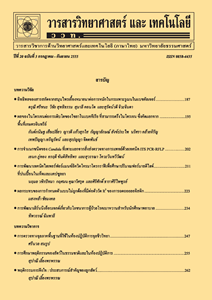การศึกษาปัจจัยสำคัญแห่งความสำเร็จของกระบวนการปรับปรุงอย่างต่อเนื่องในองค์กรที่บริหารแบบอเมริกันและแบบญี่ปุ่น : กรณีศึกษาอุตสาหกรรมอิเล็กทรอนิกส์
Main Article Content
Abstract
บทคัดย่อ
งานวิจัยนี้มุ่งศึกษาปัจจัยสำคัญแห่งความสำเร็จของกระบวนการปรับปรุงอย่างต่อเนื่อง หรือไคเซ็น (Kaizen) ในโรงงานอิเล็กทรอนิกส์จำนวน 4 แห่งซึ่งตั้งอยู่ในประเทศไทย เพื่อศึกษาเปรียบเทียบระหว่างองค์กรที่มีการบริหารแบบอเมริกันและแบบญี่ปุ่น วิธีวิจัยเริ่มจากการศึกษาวรรณกรรมที่เกี่ยวข้องเพื่อรวบรวมปัจจัยสำคัญทั้งหมด 16 ปัจจัย 4 มุมมอง ปัจจัยเหล่านี้ถูกจำแนกเป็นปัจจัยแบบรูปธรรมและปัจจัยแบบนามธรรม การรวบรวมข้อมูลทำได้โดยการสัมภาษณ์และเก็บแบบสำรวจจากผู้เชี่ยวชาญจำนวน 8 ท่านจากบริษัทที่เป็นกรณีศึกษา วิธีการวิเคราะห์ใช้กระบวนการลำดับชั้นเชิงวิเคราะห์ หรือ AHP (Analytic Hierarchy Process) ร่วมกับหลักการพาเรโต ผลการวิจัยพบว่าปัจจัยสำคัญต่อความสำเร็จของกระบวนการปรับปรุงอย่างต่อเนื่องระหว่างองค์กรที่มีการบริหารแบบสไตล์ญี่ปุ่นและองค์กรสไตล์อเมริกันมีความสอดคล้องกัน 5 ปัจจัย โดยแบ่งออกเป็นปัจจัยแบบรูปธรรม 3 ด้าน คือ 1) ระบบคุณภาพและระบบการจัดการ 2) การควบคุมกระบวนการและการปรับปรุง 3) การควบคุมและการทำมาตรฐาน ส่วนปัจจัยที่เป็นนามธรรมได้แก่ ปัจจัยที่ 4) แผนและกลยุทธ์ และ 5) วัฒนธรรมองค์กร ผลการการวิจัยบ่งชี้ว่าทั้งปัจจัยแบบนามธรรมและปัจจัยแบบรูปธรรมต่างก็มีผลต่อความสำเร็จในการปรับปรุงอย่างต่อเนื่อง นอกจากนี้องค์กรที่มีสไตล์การบริหารแบบอเมริกันจะเน้นปัจจัยสำคัญหนึ่งซึ่งเป็นลักษณะเฉพาะตัว คือ การศึกษาและอบรม ซึ่งอยู่ในมุมมองหลักองค์กรและวัฒนธรรม ส่วนองค์กรที่มีสไตล์การบริหารแบบญี่ปุ่นจะเน้นปัจจัยสำคัญหนึ่งซึ่งเป็นลักษณะเฉพาะตัว ได้แก่ คำมั่นสัญญาของฝ่ายบริหารสูงสุดและความเป็นผู้นำ ซึ่งอยู่ในมุมมองหลักองค์กรและวัฒนธรรม และเป็นปัจจัยแบบนามธรรมเช่นกัน
คำสำคัญ : ไคเซ็น; กระบวนการลำดับชั้นเชิงวิเคราะห์; ปัจจัยสำคัญแห่งความสำเร็จ
Abstract
This research investigates the critical success factors (CSF) of continuous process improvement or kaizen in four electronics companies in Thailand. The main objective is to determine whether the CSF’s are different between the American-style companies and Japanese-style companies operating in Thailand. The research methodology started with reviewing existing literature to identify the CSF’s of kaizen as discussed in previous studies. The literature research revealed that both tangible and intangible factors were important to the success of kaizen, and sixteen common factors were identified and put into the questionnaire. Data collection was performed by interviewing 8 experts from the case studies with the structured questionnaire constructed from the literature. The data was then analyzed by employing the Analytic Hierarchy Process (AHP) along with the Pareto principle. It was found that the most important CSF’s were nearly the same among both American and Japanese firms. These were three tangible factors and two intangible factors. The tangible factors were quality management system, process control and improvement, and control and standardization. The remaining intangible factors were: strategy and plan, and organization culture. The findings also revealed that the remaining factors that were different among both types of companies were education and training which was of great significance to the American-style companies, and top management commitment which was of great importance to the Japanese-style companies.
Keywords: Kaizen; analytical hierarchy process; critical success factors


